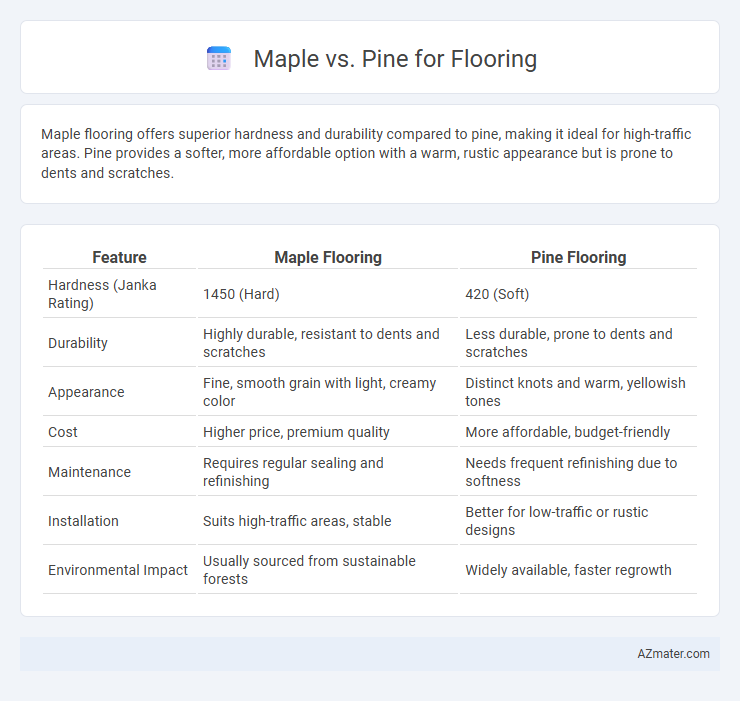Maple flooring offers superior hardness and durability compared to pine, making it ideal for high-traffic areas. Pine provides a softer, more affordable option with a warm, rustic appearance but is prone to dents and scratches.
Table of Comparison
| Feature | Maple Flooring | Pine Flooring |
|---|---|---|
| Hardness (Janka Rating) | 1450 (Hard) | 420 (Soft) |
| Durability | Highly durable, resistant to dents and scratches | Less durable, prone to dents and scratches |
| Appearance | Fine, smooth grain with light, creamy color | Distinct knots and warm, yellowish tones |
| Cost | Higher price, premium quality | More affordable, budget-friendly |
| Maintenance | Requires regular sealing and refinishing | Needs frequent refinishing due to softness |
| Installation | Suits high-traffic areas, stable | Better for low-traffic or rustic designs |
| Environmental Impact | Usually sourced from sustainable forests | Widely available, faster regrowth |
Overview: Maple vs Pine Flooring
Maple flooring offers a hard, durable surface with a fine, consistent grain that resists dents and scratches, making it ideal for high-traffic areas. Pine flooring features a softer texture with prominent knots and a warm, rustic appearance, but it is more prone to dents and wear over time. Choosing between maple and pine depends on desired aesthetics, durability requirements, and maintenance preferences.
Key Differences Between Maple and Pine
Maple flooring offers superior hardness and durability compared to pine, with a Janka hardness rating of approximately 1450 versus pine's 420-870 depending on the species, making it ideal for high-traffic areas. Maple has a fine, uniform grain and a light creamy color that provides a smooth, modern aesthetic, while pine features more prominent knots and a warmer, rustic appearance. Pine is softer and more prone to dents and scratches, making it a budget-friendly choice for low-traffic spaces or vintage-style interiors.
Appearance and Grain Patterns
Maple flooring features a light, creamy color with subtle grain patterns that create a smooth, uniform appearance, making it ideal for modern and minimalist interiors. Pine offers a warm, rustic look with distinct knots and pronounced grain variations, adding character and charm to traditional or country-style spaces. The choice between maple and pine depends on desired aesthetic: maple provides a sleek, consistent finish, while pine delivers natural, textured visual interest.
Durability and Hardness Comparison
Maple flooring is renowned for its exceptional hardness, rating around 1450 on the Janka hardness scale, making it highly resistant to dents and scratches. Pine, with a Janka rating of approximately 420, is significantly softer and more prone to dents, but it offers a rustic appearance favored in certain interior designs. Durability-wise, maple outperforms pine due to its dense grain structure, providing longer-lasting floors in high-traffic areas and commercial settings.
Cost and Budget Considerations
Maple flooring typically commands higher prices than pine due to its density and durability, making it a costlier investment for homeowners on a tight budget. Pine, being a softer wood, offers a more affordable flooring option with lower initial costs but may incur higher maintenance expenses over time due to its susceptibility to dents and scratches. Evaluating both upfront costs and long-term value helps determine the most budget-friendly choice for flooring projects.
Installation and Maintenance Needs
Maple flooring requires precise installation due to its hardness, making professional expertise essential to avoid damage during fitting, while pine's softer texture allows for easier DIY installation. Maple floors need regular maintenance with non-abrasive cleaners to preserve their smooth finish, whereas pine demands periodic resealing and can be more susceptible to dents and scratches, necessitating frequent touch-ups. Choosing between maple and pine hinges on balancing maple's durability and maintenance ease against pine's simpler installation but higher upkeep.
Suitability for High-Traffic Areas
Maple flooring is highly suitable for high-traffic areas due to its exceptional hardness and durability, with a Janka hardness rating of around 1450, making it resistant to dents and scratches. Pine, with a lower Janka hardness of approximately 380, is softer and more prone to wear, making it less ideal for spaces with heavy foot traffic. For commercial or busy residential settings, maple provides a longer-lasting, low-maintenance flooring solution compared to pine.
Environmental Impact and Sustainability
Maple flooring is sourced from slower-growing hardwood trees, resulting in a denser material but potentially less sustainable due to longer regeneration times compared to pine. Pine, being a fast-growing softwood, offers a more renewable option with quicker replenishment rates, reducing deforestation pressures. Both woods can be environmentally responsible when harvested under certified sustainable forestry practices, but pine generally has a smaller carbon footprint due to its rapid growth cycle.
Pros and Cons of Maple Flooring
Maple flooring offers exceptional durability and resistance to wear, making it ideal for high-traffic areas and homes with pets or children. Its light, uniform color with fine grain provides a clean, modern aesthetic but can show scratches and dents more easily than harder woods like oak. While maple is more affordable than exotic hardwoods, it requires regular maintenance to preserve its finish and prevent discoloration over time.
Pros and Cons of Pine Flooring
Pine flooring offers a warm, rustic aesthetic with its natural knots and grain patterns, making it a popular choice for traditional or country-style interiors. It is softer than harder woods like maple, which allows for easier installation and shaping but also means it is more prone to dents and scratches, requiring regular maintenance to preserve its appearance. Pine is also more cost-effective and sustainable, but homeowners should anticipate more frequent refinishing compared to durable options such as maple, which boasts superior hardness and resistance to wear.

Infographic: Maple vs Pine for Flooring
 azmater.com
azmater.com